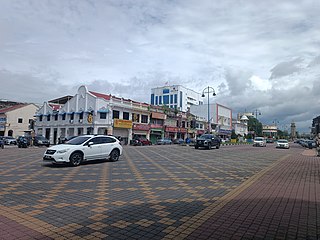
Slim River is a small town in Muallim District, Perak, Malaysia. It is about 100 km from Kuala Lumpur. It is situated in the southern part of Perak and is 20 km north of Tanjung Malim. It is about 100 km from Ipoh. The town is surrounded by many small villages.

Sungai Petani is a town in Kuala Muda District, Kedah, Malaysia. Sungai Petani is Kedah's largest city and is located about 55 km south of Alor Setar, the capital of Kedah, and 33 km northeast of George Town, the capital city of the neighbouring state of Penang.
Penang Sign Language was developed in Malaysia by deaf children, outside the classroom, when oralism was predominant. It is now mainly used by older people, although many younger people can understand it.

Methodist Boys' School, Kuala Lumpur is a semi-government aided Cluster School of Excellence and High Performance School in Kuala Lumpur, Malaysia. It was founded in July 1897, making it one of the oldest schools in Malaysia. It is known as MBS and its students are known as MBSians. The school is also known as Horley School, a reference to one of its principals, Rev. William E. Horley, who was responsible for changing and giving the school its present name from the previous name of Anglo-Tamil School. The name Horley School has been widely misunderstood as a reference to marble, which is also called Horley in Chinese, a game that was popular amongst its students then. It is noted for its library, which attracts visits from many other schools.
e-pek@k is a project that facilitates the usage of information and communication technologies to provide the services for the hearing impaired community in Malaysia.
Sekolah Menengah Sains Muar is a full boarding public residential school in Tanjung Agas, Tangkak, Johor, Malaysia. It is the only government-funded school in the Tangkak district bearing the title Science School. In 2011, the school was awarded with the Sekolah Berprestasi Tinggi or High Performance School title, awarded to schools in Malaysia that have met stringent criteria including academic achievement, strength of alumni, international recognition, network and linkages. Their performance in the recent 2022's Sijil Pelajaran Malaysia examination is GPS of 1.54.

Rawang is a town and a mukim in Gombak District, Selangor, Malaysia, about 23 km northwest of city centre Kuala Lumpur.

Penang Chinese High School (PCGHS) is a secondary school in Penang, Malaysia. Often referred to as "Bin Hua" among the local Chinese community in Penang, the school provides continuous education, ranging from pre-primary or kindergarten to pre-university studies.
Sekolah Menengah Kebangsaan Hamid Khan is a secondary school in Island Glades, Penang, Malaysia.

Gelang Patah is a bustling town in Iskandar Puteri, Johor Bahru District, Johor, Malaysia. It was administered by ruling coalition, Barisan Nasional (BN) for over 5 decades until the 13th Malaysian General Elections. BN lost to the opposition, Pakatan Harapan in the 14th General Election as well as the 15th.
High School Batu Pahat (HSBP) (Malay: Sekolah Menengah Kebangsaan Tinggi Batu Pahat (SMKTBP); abbreviated as Sekolah Tinggi Batu Pahat (STBP) also known as Sekolah Menengah Kebangsaan Tinggi Batu Pahat formally) is a secondary school for boys located in the town of Batu Pahat in the state of Johor, Malaysia. It was known as Government English School previously, but was changed to High School Batu Pahat after the independence of Malaysia.

Tanjong Bungah is a suburb of George Town in the Malaysian state of Penang. It is located along the northern coast of Penang Island between Batu Ferringhi and Tanjong Tokong, about 6.5 km (4.0 mi) northwest of the city centre.
This articles concerns the educational institutions of Penang. There are 271 primary schools and 125 secondary schools in Penang.

Ibrahim Secondary School is a morning session National Secondary School (SMK) in Sungai Petani, Kedah, Malaysia. It is a co-education school which offers education level from Form 1 to Form 5 and as well as Form 6. It also provides dormitory for students who wish to reside at the school's dormitory. Students of the school are commonly referred as Ibrahimians.

Chung Ling High School is a secondary school in George Town, Penang, Malaysia. It was initially established in 1917 as a primary school, and later became a junior high school in 1923, becoming the oldest extant Chinese high school in Malaysia. Following the merger of The Chinese High School in Singapore in 2005, Chung Ling High School became the oldest surviving Chinese high school in Southeast Asia.
Sekolah Menengah Kebangsaan (Perempuan) Sri Aman or also known as SMK (P) Sri Aman, is a Malaysian girls' secondary school. It was recently awarded the title Cluster School of Excellence by the Malaysian Ministry of Education. Recently, the school was announced as one of the top 100 schools in Malaysia by the Malaysian Ministry of Education, thus receiving the title 'High Performance School'.

Bukit Mertajam High School is a secondary school located in Bukit Mertajam, Penang, Malaysia.

Tenby Schools Penang is an international school in Penang, Malaysia, and part of the Tenby International School family. It offers both British curriculum (IGCSE) and Malaysian curriculum in the same campus for children aged 3–18 years old.

St. George's Girls' School is an all-girls secondary school in George Town, Penang, Malaysia. Originally established in 1885, it is notable for its academic achievements and notable alumnae from different racial, ethnic and cultural backgrounds, leading to its inclusion in the Malaysian Ministry of Education's Cluster School and High Performance School systems. The school is academically selective, accepting only the top ten percentile of students from a number of primary schools, including Islands Girls' School, Northam Road Primary Girls' School, and Residency Road Girls' School. The teaching curriculum and environment is secular, making it popular with students from diverse racial, ethnic and/or religious affiliations. School facilities include well-equipped science laboratories, athletic field tracks, tennis courts, gymnasium for gymnastic training, and school canteen where students can buy inexpensive meals.
High Performance School also known as HPS is a prestigious title conferred to a group of schools in Malaysia that have ethos, character and a unique identity to excel in all aspects of education. The schools have a tradition of high culture and excellent work with the national human capital and continuing to grow holistically and are competitive in the international arena. The title is given by Malaysian Ministry of Education (MOE). This is a section of a part of the National Key Result Areas of Government Transformation Programme (GTP).











